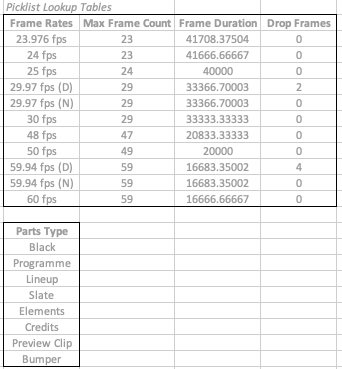Programme layout spreadsheet with drop/non-drop frame timecode durations (and no macros)
A sample spreadsheet for a programme layout providing rows for each part which consist of:
- part type
- timecode in
- timecode out
- duration
Hidden pick lists provide frame rate selection and part type selection values.
Hidden columns provide time in, time out and duration calculated as both frame count (drop and non-drop) and microsecond values.
- Frame rates from 23.976 fps up to 60 fps including 29.97 and 59.94 fps (both drop frame and non-drop frame)
- No macros, so spreadsheets using this can be easily distributed
- Conversion between timecode, frames and duration in microseconds
- Automatic timecode formatting including
;for drop frame - Invalid value highlighting including checks for invalid frame count, invalid seconds, invalid minutes and negative values
Picklists which drive programme frame rate selection and part type selection:
The programme layout table with intermediate value columns hidden:
The programme layout table with intermediate value columns shown:
The following are mostly notes to myself so that I can remember what everything does...
Formatting for drop frame or non-drop frame is based on whether the selected frame rate includes D in the value:
=ISNUMBER(SEARCH("D",$G$3))
The cell formatting applied is:
- Non-drop frame:
00\:00\:00\:00 - Drop frame:
00\:00\:00\;00
Invalid value formatting is applied if:
-
text length of the value is not 8 characters
-
if the value is less than 0
-
if seconds or minutes is greater than 59
-
if the frame value is greater than allowed for the selected frame rate
=OR(LEN(TEXT(J3, "00000000")) <> 8, VALUE(H3) < 0, VALUE(MID(TEXT(J3, "00000000"), 3, 2)) > 59, VALUE(MID(TEXT(J3, "00000000"), 5, 2)) > 59, VALUE(MID(TEXT(J3, "00000000"), 7, 2)) > LOOKUP($G$3, $B$3:$B$13, $C$3:$C$13))
Entries are greyed out if the row entry is not in use (indicated by description not having a value selected):
=ISBLANK($I3)
The following formula converts from timecode to frame count:
=(VALUE(LEFT(TEXT(J3, "00000000"), 2)) * 60 * 60 + VALUE(MID(TEXT(J3, "00000000"), 3, 2)) * 60 + VALUE(MID(TEXT(J3, "00000000"), 5, 2))) * (LOOKUP($G$3, $B$3:$B$13, $C$3:$C$13) + 1) + VALUE(MID(TEXT(J3, "00000000"), 7, 2))
The following formula converts from frame count to drop frame count:
=K3 - ((((VALUE(LEFT(TEXT(J3, "00000000"), 2)) * 60) + VALUE(MID(TEXT(J3, "00000000"), 3, 2))) * LOOKUP($G$3, $B$3:$B$13, $E$3:$E$13)) - (TRUNC(((VALUE(LEFT(TEXT(J3, "00000000"), 2)) * 60) + VALUE(MID(TEXT(J3, "00000000"), 3, 2))) / 10) * LOOKUP($G$3, $B$3:$B$13, $E$3:$E$13)))
The following formula converts from drop frame count to microseconds:
=L3 * LOOKUP($G$3, $B$3:$B$13, $D$3:$D$13)
The following formula converts from microseconds to timecode:
=INT(TEXT(TRUNC(R3 / (60 * 60 * (LOOKUP($G$3, $B$3:$B$13, $C$3:$C$13) + 1))), "00") & TEXT(TRUNC(MOD(R3, (60 * 60 * (LOOKUP($G$3, $B$3:$B$13, $C$3:$C$13) + 1))) / (60 * (LOOKUP($G$3, $B$3:$B$13, $C$3:$C$13) + 1))), "00") & TEXT(TRUNC(MOD(MOD(R3, (60 * 60 * (LOOKUP($G$3, $B$3:$B$13, $C$3:$C$13) + 1))), (60 * (LOOKUP($G$3, $B$3:$B$13, $C$3:$C$13) + 1))) / (LOOKUP($G$3, $B$3:$B$13, $C$3:$C$13) + 1)), "00") & TEXT(MOD(MOD(MOD(R3, (60 * 60 * (LOOKUP($G$3, $B$3:$B$13, $C$3:$C$13) + 1))), (60 * (LOOKUP($G$3, $B$3:$B$13, $C$3:$C$13) + 1))), (LOOKUP($G$3, $B$3:$B$13, $C$3:$C$13) + 1)), "00"))
MIT © Vectronic


